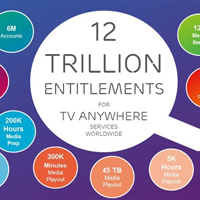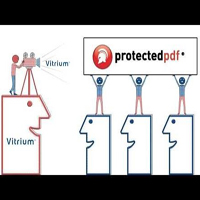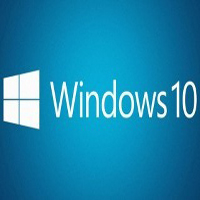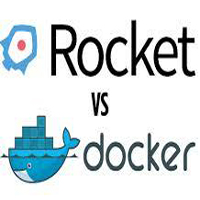In This Issue
- IoT Security Concerns
- Cloud Compute Risks
- Video Piracy Solutions
- Report from the CEO
- Streaming Twitter App
- Ericsson Studio DRM
- Vitrium DRM for Mobile
- Playready 3.0 4K DRM
- Infonetics: CSS Mrkt.
- Security Challenge
- Microsoft Enterprise IT
- AWS Earns $5.2 Billion
- Google Docker Rival
- HP Stands-Up HANA
- 4 Reasons SMB Cloud
- Groups Ask FCC Delay
- Coming DCIA Events
The IoT Brings Opportunities and Security Concerns
Excerpted from Baseline Report by Bob Violino
 The Internet of Things (IoT) continues to gain traction as companies look to leverage the possibilities of linking millions of assets, products, and other “things” via the Internet.
The Internet of Things (IoT) continues to gain traction as companies look to leverage the possibilities of linking millions of assets, products, and other “things” via the Internet.
At the same time, the security implications of IoT are a key issue. How do you ensure the protection and privacy of all the data that’s moving from machine-to-machine (M2M), or data that’s being accessed via corporate networks? Organizations will need to keep the data security requirements top-of-mind as they launch IoT initiatives.
The potential benefits of IoT are clear. “IoT promises to offer an unprecedented level of granular, real-time data that improves any business or planning process for a company that has any logistical dependence,” says Mike Spanbauer, Vice President of Research at NSS Labs, an information security research and advisory company.
One prime example Spanbauer cites involves delivery service companies that are driving rapidly into IoT with route-planning systems that update their delivery paths based on current traffic or weather and an individual truck’s current fuel levels. Other industries, such as retail and healthcare, can also see great uses for IoT.
“For years now, retailers have sought to capture behavioral data through loyalty programs and thus coupon or incentivize add-on purchases… Read More
Cloud Computing Is Convenient but Poses Risks
Excerpted from The Tennesseean Report by Sese Bennett
 Just like a real cloud in the sky, the cloud that is hovering over the IT world can be a thing of beauty. It offers easy access to data from anywhere, quick set-up, and scalability.
Just like a real cloud in the sky, the cloud that is hovering over the IT world can be a thing of beauty. It offers easy access to data from anywhere, quick set-up, and scalability.
But just like the real thing, the cloud can also produce a lot of rain in the form of data breaches and other unforeseen business disruptions. A recent survey found that 75 percent of IT decision-makers are “extremely anxious” about security issues stemming from use of the cloud.
Cloud service providers who have had service disruptions that in some cases may have involved security incidents include some of the biggest names in the business, including Google, Amazon, Microsoft, Oracle, and Intuit.
Among the things to be concerned about:
While software-as-a-service (SaaS) makes it easy to access business applications and relieves companies of running software on their own servers, it carries risks as well. Transparency often is low. Do you know where your SaaS provider keeps your data or what security measures it employs?
Data centers can be anywhere. Would you feel secure, for example, if you knew that your sensitive data was sitting on a server in China… Read More
Video Creators Look for Piracy Solutions to Protect Breakout Hits
Excerpted from Streaming Media Magazine Report by Troy Dreier
 For computer shoppers in the late ’90s, it was all about the megahertz. Does this model have 266MHz? 300MHz? Is it a screamer at 500MHz? Every bump up represented a huge boost in computing power.
For computer shoppers in the late ’90s, it was all about the megahertz. Does this model have 266MHz? 300MHz? Is it a screamer at 500MHz? Every bump up represented a huge boost in computing power.
At a certain point, however, megahertz stopped mattering. Unless you’re a professional video or photo editor, or your job requires crunching giant databases, any machine will probably deliver the power you need.
Years ago, computing power became good enough and we all stopped worrying about it. We’re now at that point with television, with many providers delivering “good enough” TV. A decade ago, you needed 500 channels and a few premium movie services just to find something to watch. That’s no longer the case.
Basic cable channels are creating quality series that get serious buzz. There’s so much quality on TV nowadays that you simply can’t watch it all — you’d never leave the couch.
The subscription video on demand (SVoD) services — Netflix, Amazon, Hulu, and so on — have figured out that the way to get noticed is to create quality original programs. They’re succeeding commercially, thanks to series such as “House of Cards,” “Orange Is the New Black,” and “Transparent,” and they’re winning awards as well… Read More
Report from DCIA CEO Marty Lafferty
 At the request of member companies, the Distributed Computing Industry Association (DCIA) is establishing a new working group to drive advancement of digital rights management (DRM) technologies, services, and business practices.
At the request of member companies, the Distributed Computing Industry Association (DCIA) is establishing a new working group to drive advancement of digital rights management (DRM) technologies, services, and business practices.
Consumer acceptance of remote data storage, mobile cloud services, Internet protocol television (IPTV), social networking, over-the-top (OTT) video, Internet of Things (IoT), and similar trends is rapidly increasing.
There has been corresponding growth in the need for improvement of Internet access control solutions to protect the integrity of high-value content and proprietary data, provide optimal usability, and ensure the security and privacy of consumers and enterprise end-users.
Industry participants confirm that the time is right for an initiative totally focused on the advancement of digital rights management (ADRM).
Unlawful attempts to justify digital infringement and disruption are now threatening even more than the economic insult inflicted by the pirating of music tracks or the hacking of company emails.
The emergence of the IoT is heralding such advances as connected automobiles and embedded medical devices; and overturning their related data systems can result not only in data loss, but also in serious physical injury or death.
The ADRM Working Group will create a conduit for processing, organizing, and focusing consumer feedback; a forum for providing legal oversight and influencing regulatory and legislative actions; and a platform for coordinating technical direction as these relate to access control in the digital ecosystem.
Initially, the group will focus on completing its voluntary code of conduct, an initial draft of which is offered in the DRM Manifesto white-paper published on the DCIA website.
DRM solutions providers and related companies are encouraged to participate and invited to contact adrm@dcia.info for more information. Share wisely, and take care.
Streaming Twitter App Steals the Show on Boxing’s Big Night
Excerpted from NY Times Report by Richard Sandomir
 Periscope, the Twitter live-streaming app, barged its way onto sports’ biggest stage on Saturday as Floyd Mayweather Jr. defeated Manny Pacquiao in Las Vegas, NV. How many thousands of people watched the bout via Periscope is not easy to calculate, but for those who did, the rogue approach to viewership represented saving a pay-per-view fee of as much as $100 — and a potentially worrisome moment for rights holders.
Periscope, the Twitter live-streaming app, barged its way onto sports’ biggest stage on Saturday as Floyd Mayweather Jr. defeated Manny Pacquiao in Las Vegas, NV. How many thousands of people watched the bout via Periscope is not easy to calculate, but for those who did, the rogue approach to viewership represented saving a pay-per-view fee of as much as $100 — and a potentially worrisome moment for rights holders.
Using Periscope requires nothing more than holding up a smartphone to a screen and streaming a live event to countless others in real time. The picture is secondhand, and certainly not as clear as that on a 50-inch HD screen, but that is a small sacrifice to get the so-called fight of the century for nothing.
A tweet from one such viewer summed up the appeal: “Arena seats at the MGM? $32K. Paying for PPV? $100. Streaming via #Periscope? Priceless, literally.”
But bothersome, certainly, to broadcasters, like HBO and Showtime, which jointly televised Saturday’s fight, and to the promoters responsible for the participants’ nine-figure paydays. It’s hard to look at Mayweather, Pacquiao, or cable operators as sad-sack victims of thievery, but Periscope’s mere existence certainly enabled the piracy: Just point your camera… Read More
Ericsson DRM Delivers Studio-Approved Protection for All Content Models
Excerpted from Your Communications News Report
 Modern media consumers have come to expect access their content anywhere, anytime, on any type of device, and growing consumer demand is driving rapid changes in the way digital content is created and distributed.
Modern media consumers have come to expect access their content anywhere, anytime, on any type of device, and growing consumer demand is driving rapid changes in the way digital content is created and distributed.
In this complex, evolving environment, the Ericsson Digital Rights Management (DRM) framework provides highly secure, flexible, market-leading features designed to meet the needs of content providers and consumers alike.
The basic role of any DRM system is to protect digital content from unauthorized use, allowing content owners to properly monetize their valuable intellectual property (IP). But the marketplace for digital media is highly fragmented, with a variety of entitlements offered across multiple device types with differing screen resolutions, security mechanisms, and other abilities.
Furthermore, while over the top (OTT) distribution requires entitlements based on device, location, and network type, live content entitlements require mechanisms for time-shifted viewing, advertisement support, and recording.
“Content owners need the maximum protection for their content, whereas content consumers need the maximum flexibility and choice,” says Farjola Peco, Mediacom Technology Strategist at Ericsson. “The balance between these needs has always been elusive, and has been a major focus in the development of Ericsson DRM… Read More
Vitrium Releases Strong 256-Bit Encryption DRM for Mobile Users
Excerpted from Benzinga Press Release
 Confidential documents secured with the Protectedpdf v5.5 web link from Vitrium will now be secured by default using the latest standard in 256-bit AES military grade encryption without the need for end-users to download plugs or proprietary viewers to open it on the other end.
Confidential documents secured with the Protectedpdf v5.5 web link from Vitrium will now be secured by default using the latest standard in 256-bit AES military grade encryption without the need for end-users to download plugs or proprietary viewers to open it on the other end.
The highly secured document is viewable on any modern browser and mobile users will find this DRM document security technology to be more lightweight than many others on the market today.
Organizations with highly sensitive documents, and those who must meet strict compliance and governance obligations, will find this zero-footprint encryption valuable, particularly for mobile end-users. The document-level wrap-around security solution can now meet the need for good governance in regards to confidential information that might travel outside of the perimeter, or be synced to cloud-based file sharing services. Industries that require strong protection will find this enhancement particularly relevant.
Protectedpdf 256-bit encryption is applied to the secured HTML5 web link at the time the document is secured, and includes: full 256-bit AES military grade encryption for web linked documents in both online and offline mode… Read More
Windows 10’s PlayReady 3.0 Mandates Hardware DRM for 4K Playback
Excerpted from ExtremeTech Report by Joel Hruska
 Microsoft’s Windows 10 doesn’t just implement DirectX 12 or combine the GUI styles of Windows 7 and Windows 8 — it also implements a new DRM system for video and audio content. The low-level details of how that system functions are still unknown, but one thing we do know is that the PlayReady 3.0 system is based on and requires hardware DRM. Microsoft is positioning this as a necessity for 4K content, which could have significant impact on which Windows 10 PCs can play protected streams and which cannot.
Microsoft’s Windows 10 doesn’t just implement DirectX 12 or combine the GUI styles of Windows 7 and Windows 8 — it also implements a new DRM system for video and audio content. The low-level details of how that system functions are still unknown, but one thing we do know is that the PlayReady 3.0 system is based on and requires hardware DRM. Microsoft is positioning this as a necessity for 4K content, which could have significant impact on which Windows 10 PCs can play protected streams and which cannot.
Microsoft has kept some aspects of this system semi-secret — the public talk given at WinHEC about hardware DRM protection in Windows 10 cuts off just after the topic comes up — but we found the unredacted slides from the same presentation online. They don’t tell us everything, but we can draw some conclusions from what’s been published to-date.
Microsoft PlayReady already controls content protection in Windows 7 and Windows 8 PCs. It’s designed to be portable and cross-platform, which means PlayReady 3.0, like the other components of the Windows 10 ecosystem, will be available on both phones and laptops / desktops.
PlayReady 3.0 supports multiple languages and all Windows development models (think Metro vs. Windows Desktop)… Read More
Infonetics: Cloud Security Services Market on the Rise
Excerpted from The Var Guy Report by Elizabeth Montalbano
 The cloud security services market will experience a slow but steady rise for the next several years, meaning it’s a good time for solution providers to step up their cloud security skills and take advantage, according to a recent report by Infonetics Research.
The cloud security services market will experience a slow but steady rise for the next several years, meaning it’s a good time for solution providers to step up their cloud security skills and take advantage, according to a recent report by Infonetics Research.
The report, “Cloud and CPE Managed Security Services (2015 Edition),” by Jeff Wilson, Principal Security Analyst for the research firm, predicts somewhere between 10 percent to 12 percent growth for the cloud security services market through 2018.
This growth is slightly lower but still fairly consistent with market growth from 2013 to 2014. In 2013, revenue in the market was at $6.3 billion, growing 13.5 percent in 2014 to 7.2 billion, according to the report. Projected revenue for 2015 is $8.1 billion, while in 2018 the market should represent about $11 billion in revenue opportunity.
Cloud-based revenue comes from security services and solutions sold in conjunction with broadband services, security for mobile devices/apps, Web and application hosting services, and security solutions for enterprise infrastructure that has migrated into the cloud, Wilson wrote in the report. “These solutions are tightly coupled to a specific provider’s network or infrastructure… Read More
The Cloud Computing Security Challenge
Excerpted from Network World Report by John Oltsik
 A few years ago, cloud computing faced an infosec hurdle. Many CIOs appreciated the benefits of cloud computing, but their concerns about cloud security outweighed all of its potential benefits. General cloud security trepidation thus precluded broader use of cloud computing.
A few years ago, cloud computing faced an infosec hurdle. Many CIOs appreciated the benefits of cloud computing, but their concerns about cloud security outweighed all of its potential benefits. General cloud security trepidation thus precluded broader use of cloud computing.
Fast forward to 2015 and the situation has changed. Yes, CIOs and security folks remain worried about cloud security, but business and IT benefits are so appealing that they tend to trump confidentiality, integrity, and security apprehensions. ESG research indicates that a growing number of organizations are jumping on the cloud computing bandwagon (note: I am an ESG employee):
68% of mid-market (i.e. 500-999 employees) and enterprise (i.e. more than 1,000 employees) organizations use SaaS today.41% of mid-market (i.e. 500-999 employees) and enterprise (i.e. more than 1,000 employees) organizations use IaaS today. 35% of mid-market (i.e. 500-999 employees) and enterprise (i.e. more than 1,000 employees) organizations use PaaS today.
So the cloud train has clearly left the station and it’s only gaining momentum and speed. Now, remember those cloud security concerns… Read More
Microsoft Strengthens Offerings for Enterprise IT
Excerpted from Top Tech News Report by Jeff Cozza
 A slew of new products aimed at enterprise clients was announced by Microsoft earlier this week at the company’s Ignite conference in Chicago. The new offerings represent Redmond’s attempt to refocus its efforts on its lucrative business clientele, with a particular emphasis on corporate IT departments.
A slew of new products aimed at enterprise clients was announced by Microsoft earlier this week at the company’s Ignite conference in Chicago. The new offerings represent Redmond’s attempt to refocus its efforts on its lucrative business clientele, with a particular emphasis on corporate IT departments.
The new lineup includes upgraded versions of Microsoft’s SharePoint, Exchange and SQL Server lines. The company also opened up its Office 2016 suite for previews, with the updated package now supporting in-app, real-time coauthoring in an effort to make the productivity apps more appealing to office workers collaborating on projects.
While there were plenty of new business-friendly products for enterprise customers to swoon over, one particular feature geared to IT professionals will be the new Windows Update for Business. The new service is a management option for Windows 10 that keeps devices up to date with the latest security updates and features.
The new solution will help reduce management costs, provide control over update deployment, offer faster access to security updates and critical fixes, and deliver the latest upgrades on an ongoing basis, according to Microsoft. Managers will also have the option to acquire trusted software or content for entire teams and companies… Read More
Modest Patent Portfolio Doesn’t Stop AWS from Earning $5.16 Billion
Excerpted from IP Watchdog Report by Steve Brachmann
 Amazon has just cleared up the picture over its cloud computing business, Amazon Web Services (AWS) and the company’s forecast looks sunny. The corporation recently announced its first quarter earnings for 2015 and financial pundits were flabbergasted to see just how profitable AWS has been for Amazon, earning $5.16 billion in revenue over a recent 12-month period and growing at a rate of nearly 50 percent year-over-year.
Amazon has just cleared up the picture over its cloud computing business, Amazon Web Services (AWS) and the company’s forecast looks sunny. The corporation recently announced its first quarter earnings for 2015 and financial pundits were flabbergasted to see just how profitable AWS has been for Amazon, earning $5.16 billion in revenue over a recent 12-month period and growing at a rate of nearly 50 percent year-over-year.
The service had already posted 1 million customers by November of last year. North American sales for the quarter increased by 24 percent to $13.4 billion.
Importantly, Amazon Web Services isn’t just making money, it’s also generating a hefty profit for the company. Barron’s has reported that, although AWS only produces about 7 percent of Amazon’s revenues, it was the source of 37 percent of Amazon’s total profit.
Retail sales account for 92 percent of Amazon’s revenue but only 49 percent of the company’s profit. Comparatively, AWS revenues are skyrocketing at 49 percent growth in the past quarter, compared to Amazon’s overall revenue growth of 15 percent. This quarterly report is Amazon’s first to include AWS as a reportable segment, finally lifting the veil… Read More
Google Backs Rival of Docker, The Cloud’s Next Big Thing
Excerpted from Wired Report by Cade Metz
 For many, Docker is the next big thing in cloud computing. But some big names — most notably Google — are now backing an alternative to this enormously influential technology.
For many, Docker is the next big thing in cloud computing. But some big names — most notably Google — are now backing an alternative to this enormously influential technology.
In December, one of Docker’s earliest supporters, the Silicon Valley startup CoreOS, unveiled an open source project called Rocket. CoreOS founder and CEO Alex Polvi felt that Docker had strayed from its original mission, and with Rocket, he and his colleagues hoped to bring that mission back to the fore.
Five months later, Google has put its considerable weight behind this effort, officially joining the Rocket open source project and rolling the technology into one of its cloud computing tools. Polvi is set to announce Google’s involvement this morning at an event in San Francisco, and in an email to WIRED, Google has confirmed its involvement.
The irony is that Docker is based on software that underpins Google’s vast online empire. Basically, Docker is a way of more efficiently building and operating services akin to Google Search, Google Maps, and Gmail—services that run across tens, hundreds, perhaps even thousands of machines. You can think of it as a shipping container for software — a tool that lets developers neatly package their code and spread it across a vast array of machines… Read More
HP To Stand-Up Private HANA Clouds
Excerpted from Talkin’ Cloud Report by Mike Vizard
 Hewlett-Packard (HP) and SAP announced they will jointly deliver instances of SAP S/4HANA applications on the HP Helion Managed Cloud.
Hewlett-Packard (HP) and SAP announced they will jointly deliver instances of SAP S/4HANA applications on the HP Helion Managed Cloud.
While SAP may have selected IBM to host its implementation of SAP HANA in the cloud, the folks at HP are not likely to cede a market where a significant portion of the SAP applications running on premise these days are installed on HP servers.
At the Sapphire Now conference this week, HP and SAP announced they will jointly deliver instances of SAP S/4HANA applications on the HP Helion Managed Cloud.
Jules Beck, Vice President and General Manager for Global SAP Services at HP Enterprise Services, said given the fact that most organizations prefer to customize their SAP applications, HP views provided private cloud implementations of S/4HANA applications as a major opportunity.
In contrast to the public cloud service that SAP is hosting on the IBM SoftLayer cloud, Beck said HP will focus on customers that want a custom implementation of those applications that provides them more control over the environment than a public cloud. SAP is making the case for using the standard edition of its applications in the cloud… Read More
4 Reasons Small Businesses Should Migrate to the Cloud
Excerpted from Entrepreneur Report by Andre Lavoie
 Cloud computing can mean big changes for small businesses. Those changes have been realized by many of today’s small-business owners, from tech startups in the heart of Silicon Valley to urban and small-town mom-and-pop shops.
Cloud computing can mean big changes for small businesses. Those changes have been realized by many of today’s small-business owners, from tech startups in the heart of Silicon Valley to urban and small-town mom-and-pop shops.
Today, 37 percent of U.S. small businesses have fully adapted to cloud computing, and a 2014 Intuit study predicts that percentage will more than double to 80 percent by 2020. The cloud is redefining the way small businesses do business. Here are four reasons small-business owners should consider migrating to the cloud:
1. Lower costs: One of the most obvious benefits of moving everyday business to the cloud is that it can provide small businesses with significant savings. For starters, cloud computing fully utilizes hardware. Virtualization increases the value of physical server hardware, meaning businesses can do more with less.
As a result, small businesses will see a decrease in rack space, power usage, IT requirements, etc. That means lower installation, maintenance, hardware, upgrade and support costs. For small businesses, especially, those savings are invaluable.
2. Better collaboration: Collaboration is made easy in the cloud. The ability to save and access various files through the cloud… Read More
Groups Ask FCC to Delay Net Neutrality Rules
Excerpted from The Hill Report by Mario Trujillo
 A group of major Internet service providers (ISPs) is asking the Federal Communications Commission (FCC) to put part of its new Net Neutrality rules on hold during the impending court battle.
A group of major Internet service providers (ISPs) is asking the Federal Communications Commission (FCC) to put part of its new Net Neutrality rules on hold during the impending court battle.
AT&T, CenturyLink, The Wireless Association and US Telecom filed a more than 100-page petition with the FCC arguing the rules would cause irreparable harm if they take effect.
The companies and others have already launched a handful of lawsuits to try and kill the new rules. They argue those challenges are likely to succeed and want to prevent the regulations from taking effect while the lawsuits proceed.
“The commission’s drastic departure from established law threatens petitioners and the public with immediate, irreparable harm,” according to the filing.
The National Cable and Telecommunications Association and the American Cable Association filed their own joint petition minutes later.
The FCC, which approved the rules on a 3-2 vote in February, is almost certain to reject the petition… Read More
Coming Events of Interest
Data Center and Cloud Awards — June 2nd in Monaco. Europe’s most prestigious awards for data center and cloud achievements will be announced at an evening ceremony prior to the opening of Europe’s ‘must-attend’ DataCloud Europe conference and exhibition.
DataCloud Europe — June 3rd-4th in Monaco. This is eighth annual European Congress & Exhibition focusing on data center and cloud computing, and is co-located with the DataCloud 2015 Awards.
Freescale Technology Forum — June 22nd-25th in Austin, TX. FTF, this year focusing on the Internet of Things (IoT), is the heart of discovery, imagination and innovation. Together we will strategize and design the next market-shifting products.
Cloud World Forum — June 24th-25th in London England. This marquee event is presented by Informa Telecoms & Media. Co-located with the seventh annual major international conference will be Enterprise Apps World.
Cloud Computing Boot Camp — July 30th in Washington, DC. Designed for small-to-medium businesses (SMBs) and their counterparts in government agencies and healthcare organizations whose responsibilities include evaluating, purchasing, and implementing cloud-based solutions.
Internet of Things World Forum (IoTWF) — December 6th-8th in Dubai, UAE. IoTWF is an exclusive event that brings together the best and brightest thinkers, practitioners, and innovators from business, government, and academia to accelerate the market adoption of the Internet of Things.
